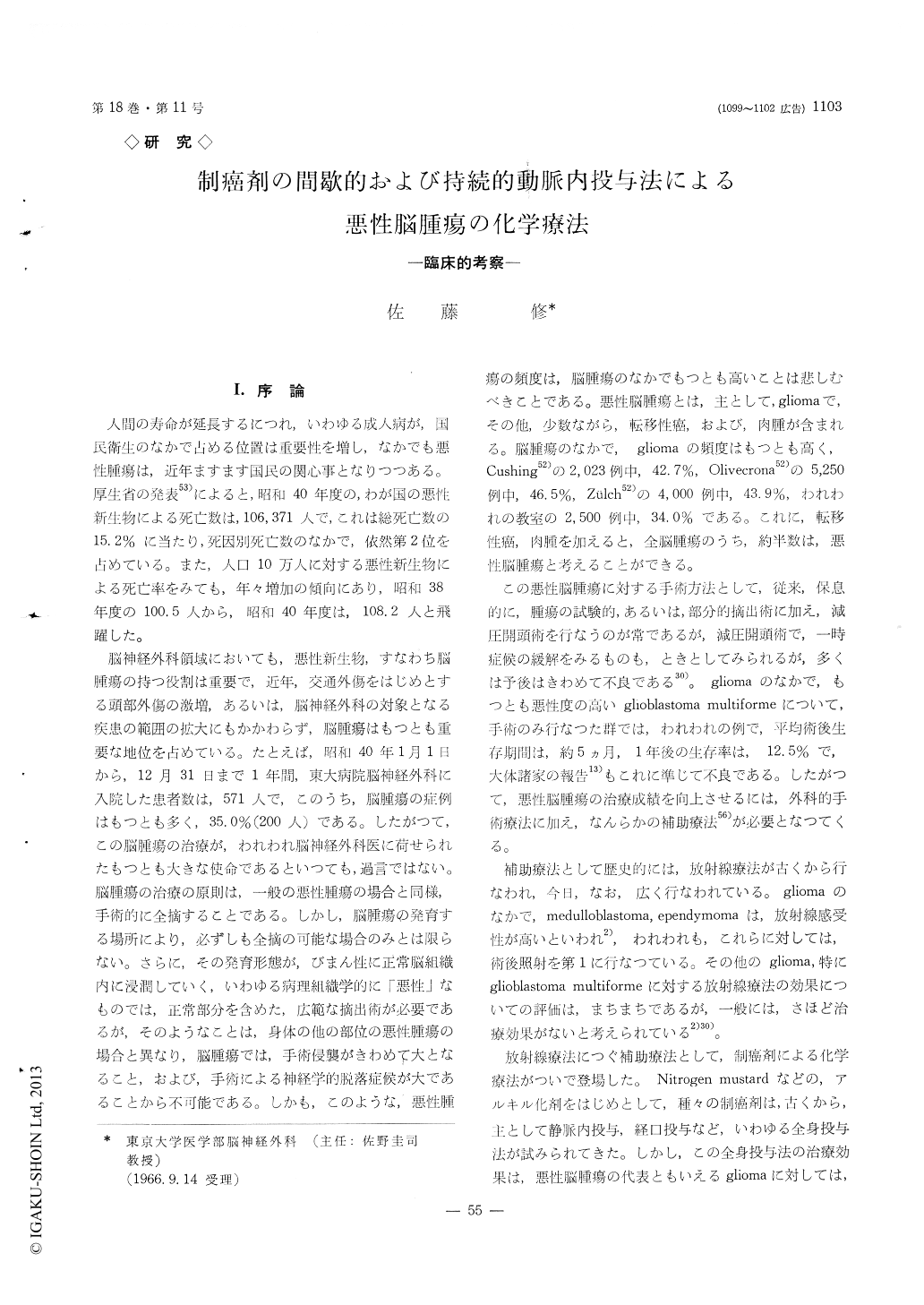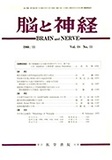Japanese
English
- 有料閲覧
- Abstract 文献概要
- 1ページ目 Look Inside
I.序論
人間の寿命が延長するにつれ,いわゆる成人病が,国民衛生のなかで占める位置は重要性を増し,なかでも悪性腫瘍は,近年ますます国民の関心事となりつつある。厚生省の発表53)によると,昭和40年度の,わが国の悪性新生物による死亡数は,106,371人で,これは総死亡数の15.2%に当たり,死因別死亡数のなかで,依然第2位を占めている。また,人口10万人に対する悪性新生物による死亡率をみても,年々増加の頃向にあり,昭和38年度の100.5人から,昭和40年度は,108.2人と飛躍した。
脳神経外科領域においても,悪性新生物,すなわち脳腫瘍の持つ役割は重要で,近年,交通外傷をはじめとする頭部外傷の激増,あるいは,脳神経外科の対象となる疾患の範囲の拡大にもかかわらず,脳腫瘍はもつとも重要な地位を占めている。たとえば,昭和40年1月1日から,12月31日まで1年間,東大病院脳神経外科に入院した患者数は,571人で,このうち,脳腫瘍の症例はもつとも多く,35.0%(200人)である。したがつて,この脳腫瘍の治療が,われわれ脳視神経外科医に荷せられたもつとも大きな使命であるといつても,過言ではない。脳腫瘍の治療の原則は,一般の悪性腫瘍の場合と同様,手術的に全摘することである。しかし,脳腫瘍の発育する場所により,必ずしも全摘の可能な場合のみとは限らない。さらに,その発育形態が,びまん性に正常脳組織内に浸潤していく,いわゆる病理組織学的に「悪性」なものでは,正常部分を含めた,広範な摘出術が必要であるが,そのようなことは,身体の他の部位の悪性腫瘍の場合と異なり,脳腫瘍では,手術侵襲がきわめて大となること,および,手術による神経学的脱落症候が大であることから不可能である。しかも,このような,悪性腫瘍の頻度は,脳腫瘍のなかでもつとも高いことは悲しむべきことである。悪性脳腫瘍とは,主として,gliomaで,その他,少数ながら,転移性癌,および,肉腫が含まれる。脳腫瘍のなかで,gliomaの頻度はもつとも高く,Cushing52)の2,023例中,42.7%,Olivecrona52)の5,250例中,46.5%, Zulch52)の4,000例中,43.9%,われわれの教室の2,500例中,34.0%である。これに,転移性癌,肉腫を加えると,全脳腫瘍のうち,約半数は,悪性脳腫瘍と考えるにとができる。
Brain tumors occupy one of the most important parts in neurosurgery. Among brain tumors, ' malign-ant' brain tumors are most frequent and such mali-gnant brain tumors are mainly gliomas and partly cancers and sarcomas which have not sharp demarca-tion and invade the normal brain tissue diffusely. For these malignant brain tumors total removal withoutany serious neurological deficit is almost impossible. So the treatment of choice for such malignant brain tumors consists of decompressive craniotomy with partial removal of the tumors as possible and some adjuvant therapies are needed later.
The efficiency of irradiation as an adjuvant therapy is considered to be questionable for gliomas other than medulloblastomas and ependymomas.
Chemotherapy with anticancer agents is also in vain by the route of systemic administration for gliomas although it has some effects for cancers and sarcomas of the brain.
The author tried intra-arterial infusion of anticancer agents for 50 cases of malignant brain tumors (36 cases of gliomas and 14 cases of cancers and sarco-mas). The method of administration was divided in two groups; fractionated intra-arterial infusion in 24 cases with Endoxan, Thio-TEPA, Mitomycin C, Ala-nine nitrogen mustard and Toyomycin and continuous intra-arterial infusion in 26 cases with Methotrexate.
By the help of both the improvement of any neuro-logical deficits and the regression of the size of the tumors, clinical effect was evaluated objectively in 22 cases of fractionated infusion and 22 cases of conti-nuous infusion which had sufficient dose of the agents and the results were as below :
(1) Among total 44 cases, 30 cases gained some effects.
(2) Fractionated infusion was more effective for gliomas and continuous infusion was more effective for cancers and sarcomas.
(3) In the cases of continuous infusion, the clin-ical effect had close relation to the duration of the infusion. That is, the duration of the infusion should be longer than 3 weeks in gliomas but in cancers and sarcomas the duration was sufficient for 2 to 3 weeks. These results were in accordance with the theory of 'doubling time' of the tumor cells. On the contrary, there was no relation between the clinical effect and the doubling time of the tumor cells in the cases of fractionated infusion. Survival rate after the operation was also examined in glioblastoma multiforme and the survival effect was definite in the cases of intra-arterial infusion in contr-ast with the cases of systemic administration.
Soon after the beginning of the fractionated infu-sion, a marked increase in activity of glutamic-oxal-acetic transaminase in the CSF was observed in the effective cases, which may be useful to know the efficiency of the adopted agents earlier before the clinical effect appeared. But in the cases of the conti-nuous infusion the increase was moderate and delayed for 2 or 3 weeks after the beginning of the infusion even in the cases with marked effect.
Among toxicities of Methotrexate, the secondary brain edema due to the toxic effect to the normal brain tissue was important. This secondary brain edema would be able to be the cause of the transi-tory neurological deficits during the therapy reported in the literatures. The secondary brain edema may also cause the fever of slight degree of the central origin.
The spontaneous improvement of toxicities such as stomatitis, skin eruption and leucocytopenia were observed in the cases of Methotrexate, which sug-gested the resistance of the tumor cells to the Me-thotrexate.
Intra-arterial infusion of anticancer agents is surely more effective than the systemic administration but the results are not fully sufficient and the more effective and harmless anticancer agents are eagerly expected.

Copyright © 1966, Igaku-Shoin Ltd. All rights reserved.


